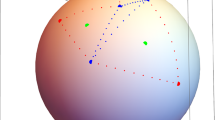Abstract
In Donnay’s and Van Brummelen’s monographs on spherical trigonometry, the Cesàro method is revitalized to derive various results on spherical triangles. Using Cesàro’s triangles, we derive in this paper some further results on spherical triangles that are not given in these books. Among these are results concerning the relation of sides of a spherical triangle and their opposite angles, Lexell’s theorem, and a result concerning the area of spherical triangles with one variable side-length. These results are applied to derive theorems of isoperimetric type for spherical polygons and the corresponding extremal properties of regular spherical polygons.







Similar content being viewed by others
References
Berger, M.: Geometry. II. Translated from the French by M. Cole and S. Levy. Universitext, Springer, Berlin (1987)
Berger, M.: Geometry Revealed. A Jacob’s Ladder to Modern Higher Geometry. Translated from the French by Lester Senechal. Springer, Heidelberg (2010)
Cecil, T.C.: Lie Sphere Geometry. With Applications to Submanifolds. Universitext, Springer, New York (1992)
Cesàro, G.: Les formules de la trigonométrie sphérique déduites de la projection stéréographique du triangle. Emploi de cette projection dans les recherches sur la sphère. Belg. Bull. Sci. 560–583 (1905) (JFM 36.0556.04)
Clemens, C.H.: Two-Dimensional Geometries. A Problem-Solving Approach. Pure and Applied Undergraduate Texts, vol. 34. American Mathematical Society, Providence (2019)
Coxeter, H.S.M.: Introduction to Geometry. Reprint of the: edition, p. 1989. Wiley Classics Library, Wiley, New York (1969)
Craig, H.V.: Review: spherical trigonometry after the Cesáro Method (by J. D. H. Donnay). Am. Math. Mon. 53(1), 32–33 (1946)
Donnay, J.H.C.: Spherical Trigonometry After the Cesàro Method. Interscience Publishers Inc, New York (1945)
Euclid: Euclid’s Elements of Geometry. The Greek text edited by J. L. Heiberg (1883–1885) from Euclid’s Elements, B. G. Teubner, Leipzig, 1883–1885, provided with a modern English translation and published by Richard Fitzpatrick (2007)
Feeman, T.: Portraits of the Earth A Mathematician Looks at Maps. Mathematical World, vol. 18. American Mathematical Society, Providence (2002)
Geiges, H.: The Geometry of Celestial Mechanics, London Mathematical Society Student Texts, vol. 83. Cambridge University Press, Cambridge (2016)
Maehara, H., Martini, H.: On Lexells theorem. Am. Math. Mon. 124(4), 337–344 (2017)
Martini, H., Montejano, L., Oliveros, D.: Bodies of Constant Width. An Introduction to Convex Geometry with Applications. Birkhäuser/Springer, Cham (2019)
Pedoe, D.: Geometry—A Comprehensive Course. Dover Publications Inc, New York (1988)
Popko, E.S.: Divided Spheres. Geodesics and the Orderly Subdivision of the Sphere. CRC Press, Boca Raton (2012)
Simonic̆, A.: Lexell’s theorem via stereographic projection, Beitr. Algebra Geom.60, 459–463 (2019)
Stillwell, J.: Geometry of Surfaces. Universitext, Springer, New York (1992)
Van Brummelen, G.: Heavenly Mathematics—The Forgotten Art of Spherical Trigonometry. Princeton University Press, Princeton (2013)
Wilson, P.M.H.: Curved Spaces. From Classical Geometries to Elementary Differential Geometry, Cambridge University Press, Cambridge (2008)
Acknowledgements
The authors are grateful to the referee for careful reading of the manuscript. Proof of Theorem 11 is corrected and improved thanks to the referee’s comments.
Author information
Authors and Affiliations
Corresponding author
Additional information
Publisher's Note
Springer Nature remains neutral with regard to jurisdictional claims in published maps and institutional affiliations.
Appendix
Appendix
Let M be the midpoint of the circular arc  , and let X be a moving point on the sub-arc
, and let X be a moving point on the sub-arc  of \(\gamma \). Put \(x=B_1X,\,y(x)=B_2X\) and \(f(x)=x+y(x)\). First, we show that
of \(\gamma \). Put \(x=B_1X,\,y(x)=B_2X\) and \(f(x)=x+y(x)\). First, we show that
For a small \(\varepsilon >0\), let P be the point on the extension of the geodesic segment \(B_1X\) beyond X such that \(XP=\varepsilon \), and Y be the point on  such that \(B_1Y=x+\varepsilon \); see Fig. 8, where
such that \(B_1Y=x+\varepsilon \); see Fig. 8, where  is a circular arc with center \(B_1\). Put
is a circular arc with center \(B_1\). Put

Then,  and
and  . Hence we have
. Hence we have
Choose a small \(\varepsilon _0\) so that  holds for \(0<\varepsilon <\varepsilon _0\). Then, from (3), we have \(\angle YXB_2>\angle YXP\). Put
holds for \(0<\varepsilon <\varepsilon _0\). Then, from (3), we have \(\angle YXB_2>\angle YXP\). Put
If \(\delta \le 0\), then \(f(x+\varepsilon )=x+\varepsilon +y(x)-\delta >f(x)\). So, we assume \(\delta >0\). This implies \(\beta <\pi /2\), and hence \(\angle YXB_2<\pi /2\).
Now, consulting Fig. 9 (in which  shows a circular arc with center \(B_2\) and \(\varGamma \) shows the circle with center X and spherical radius XY), we can see that
shows a circular arc with center \(B_2\) and \(\varGamma \) shows the circle with center X and spherical radius XY), we can see that
Since \(\angle YXY_2=2\angle YXB_2>2\angle YXP=\angle YXY_1\), we have \(YY_2>YY_1\) by Theorem 5. This implies \(XP'>XQ'\). Therefore, for every \(0<\varepsilon <\varepsilon _0\),
Thus f(x) is monotonically increasing in \(0<x<B_1M\).
Proof of Lemma 1
Let D be the point on the sub-arc  such that \(B_2D=B_1C\). Then E lies on the sub-arc
such that \(B_2D=B_1C\). Then E lies on the sub-arc  of
of  . Since M is also the midpoint of the arc
. Since M is also the midpoint of the arc  , we may consider the case that E lies on the sub-arc
, we may consider the case that E lies on the sub-arc  . In this case, \(B_1E+B_2E>B_1C+B_2C\) follows from (2). \(\square \)
. In this case, \(B_1E+B_2E>B_1C+B_2C\) follows from (2). \(\square \)
Rights and permissions
About this article
Cite this article
Maehara, H., Martini, H. On Cesàro triangles and spherical polygons. Aequat. Math. 96, 361–379 (2022). https://doi.org/10.1007/s00010-021-00820-y
Received:
Revised:
Accepted:
Published:
Issue Date:
DOI: https://doi.org/10.1007/s00010-021-00820-y
Keywords
- Cesàro’s triangle
- Girard’s theorem
- Isoperimetric problem
- Lexell’s theorem
- Spherical geometry
- Spherical polygons
- Stereographic projection





